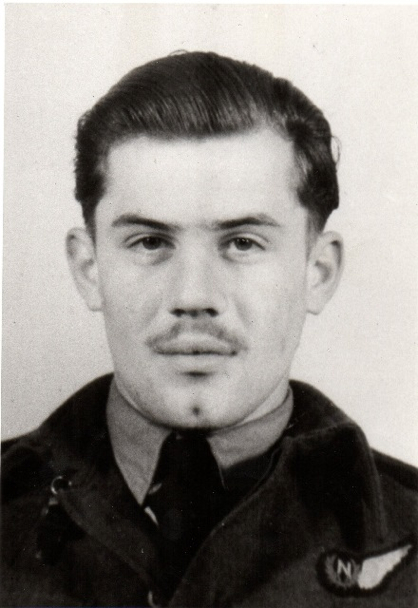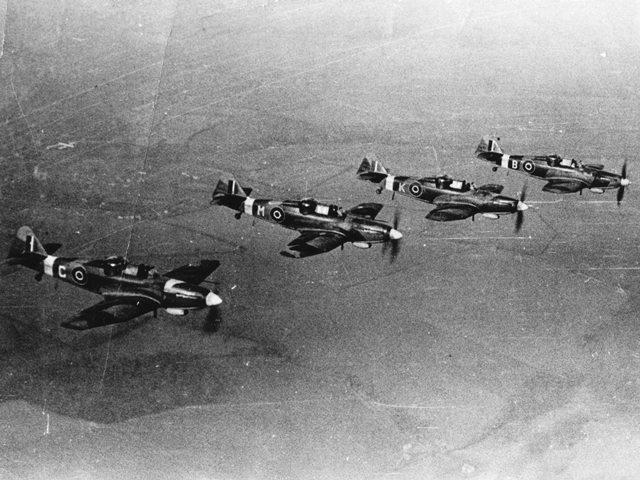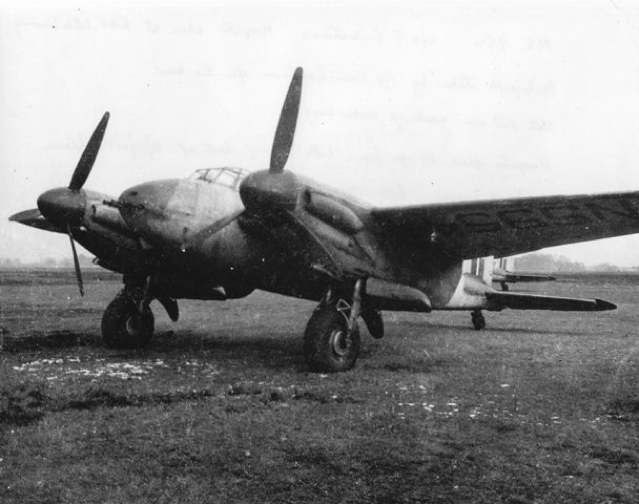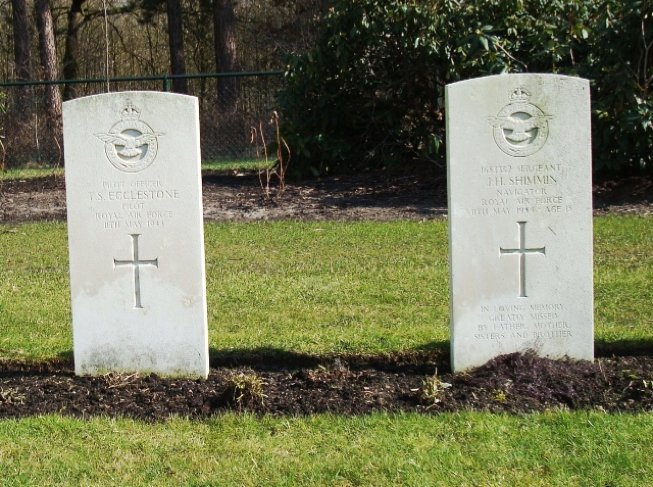Date: 11th May 1944.
Unit: No. 515 Squadron, 100 Group (Special Duties)
Type: De Havilland Mosquito Mk.FBVI.
Serial: NS932.
Coded: 3P-
Location: Wemeldinge, Netherlands
Base: Little Snoring, Norfolk.
Pilot: Pilot Officer Thomas Stanley Ecclestone, R.A.F.V.R. 176416. Age 24. – Killed.
Navigator: Sergeant John Harold Shimmin R.A.F.V.R. 1683352. Age 18. – Killed.
REASON FOR LOSS:
Mosquito MKVI (NS932) from 515 Squadron, took off at 2342h from Little Snoring, Norfolk, was seen flying at a low altitude and crashed into a searchlight on the East docks, Wemeldinge, at 0206h and as a result crashed on the Western channel dike. The bodies of both pilots were retrieved and handed over by the German Wehrmacht to the local authority, after which they were buried in the cemetery at Wemeldinge. After the war the bodies were moved to an Allied Forces military cemetery at Bergen op Zoom.
 cc
cc
Pilot Officer Thomas Stanley Ecclestone.ccccccc cccccccccccccccccccccSergeant John Harold Shimmin.
Pilot Officer THOMAS STANLEY ECCLESTONE
Tom Ecclestone was born in 1920 and brought up in Stansted, Essex, where his father owned a chemist shop. With his older brother, Bertram, he attended Bishops Stortford College. At the outbreak of war Bertram Ecclestone joined the Royal West Kent regiment and was among the last to leave Dunkerque during the evacuation. Sadly he died of wounds as a prisoner of war at El Alamein. Tom left school in 1939 and started training as an accountant before joining the RAFVR. He was finally called up in 1941 and commenced his pilot training in the USA, at the British Flying Training School in Miami, Oklahoma. On his return to England he converted his flying skills to British aircraft and joined the Defiant Flight (later 515 Squadron).
The Defiant Flight was a special duties flight and was formed in June 1942. Its role was in electronic countermeasures warfare, jamming enemy radar using Moonshine and Mandrel. Moonshine alerted enemy defences by registering on their radar as a large force of aircraft. 19th August 1942 was the day of the ill-fated Dieppe Commando Raid. When the withdrawal of Allied forces from the beaches began, 9 Defiant aircraft took off on an operational flight as a diversion to the Dieppe Commando Raid.

In this photo of a flight of 515 Squadron Defiants, Thomas is flying aircraft ‘M’
In September 1942 the squadron assumed its independent identity as 515 Squadron. On occasions over 300 enemy fighters were drawn up by ‘spoof’ entirely in the wrong direction to ward off bombing attacks by British aircraft.
In December 1942 the role of 515 Squadron changed to manipulating a Mandrel screen by night, in support of the bomber offensive. Mandrel was a noise jamming system which overwhelmed the signals of the German Freya system, and the squadron patrolled 8 predetermined positions. This Mandrel screen across the North Sea blinded German radar while Bomber Command aircraft became airborne and formed up behind it.
The use of Mandrel continued until July 1943, when the squadron became non-operational. The Defiant aircraft were not performing as required and the pilots were retrained on Blenheim and Beaufighter aircraft, converting from single-engine to twin-engine machines.

Tom’s regular Mosquito NS954 was unserviceable on the night he was killed,
it was photographed after the war here awaiting disposal. (Note: Serial painted under wing.)
In December 1943 515 Squadron was transferred to 100 (Special Duties) Group, Bomber Command, and moved to Little Snoring in Norfolk. The squadron’s work on Mandrel was completed and they were now equipped with Mosquito FB Mark VI aircraft, with its role becoming low level intruder tactics over active enemy airfields to prevent enemy fighters taking off or landing. These airfields were located in the Paris-Lille area, Brussels, Gilze Rijen, and Eindhoven in the Netherlands. In April Tom was mentioned in despatches following the destruction of two enemy fighters attempting to land at airfields near Brussels.
The 515 Squadron Operations Record Book for 10th May 1944 reads as follows: ‘Two aircraft were detailed to patrol Gilze Rijen airfield in the Netherlands, aircraft No. 932 (Pilot W/O Ecclestone, Navigator Sgt Shimmin) from 0030 – 0115h and aircraft No. 929 (Pilot Sgt White, Navigator Sgt Normington) from 2345-0030h. Since take off nothing has been heard and both aircraft and crew are missing.
Mosquito NS932 had carried out its mission to patrol the enemy airfield at Gilze Rijen in the Netherlands. It was on its way back to Norfolk when it was shot down over the Dutch coast.
On 6th May 1944, five days before his death, W/O Tom Ecclestone (12222306) was promoted by the Air Ministry to the rank of Pilot Officer, and his service number changed to 176416. However, his previous rank of Warrant Officer was still being used on the night he died. Sgt John Harold Shimmin (1683352) was one of the youngest navigators killed in action during World War II. He was just 18 years old. He was the son of William Ernest Shimmin and Anna Shimmin, from Douglas, Isle of Man.

Two claims on 26-4-44 for Ecclestone and Shimmin, seen here on the 100 Group victories board
In 100 Group’s Review of Operations, while 515 Squadron was flying Moonshine and Mandrel missions, it is recorded that ‘There is no doubt that valuable support was given to Bomber Command’s offensive, and bomber losses were considerably reduced by the work of 515 Squadron during this time.’ During night intruder operations the Squadron caused considerable confusion at enemy airfields, keeping enemy fighters away from Allied bombers. Gradually the enemy became intruder conscious as a result of these night intruder missions and opportunities of finding aircraft with navigation lights decreased.

Crews graves at Bergen-Op-Zoom War Cemetery, Plot 18. Row B. Graves 9 and 10.
Burial details:
Pilot Officer Thomas Stanley Ecclestone,
Bergen-Op-Zoom War Cemetery, Plot 18. Row B. Grave 9.
Sergeant John Harold Shimmin.
Bergen-Op-Zoom War Cemetery, Plot 18. Row B. Grave 10.
Son of William Ernest Shimmin and Anna Shimmin, of Douglas, Isle of Man.
Special thanks to Carole Paternoster for all photos and details presented here, in memory of her father Thomas Ecclestone,
and his Navigator John Shimmim.(October 2014)


The British Library is preserving this site for the future in the UK Web Archive at www.webarchive.org.uk All Aircrew Remembered on our Remembrance pages, are therefor not just remembered here, but also subsequently remembered and recorded as part of our nation’s history
and heritage at The British Library.

